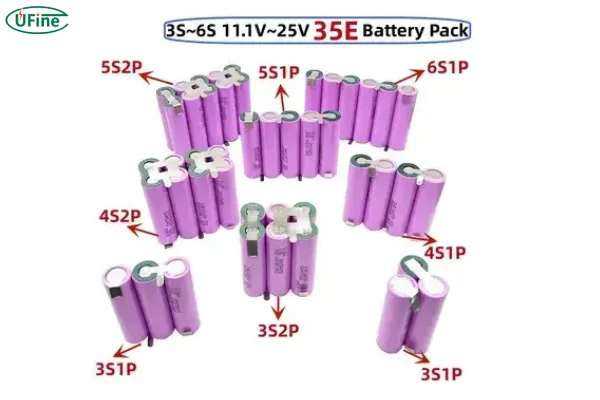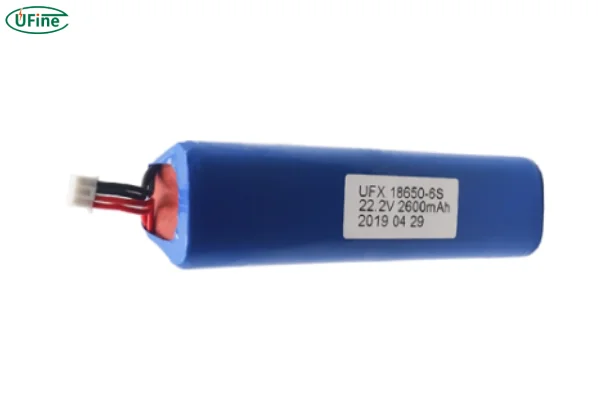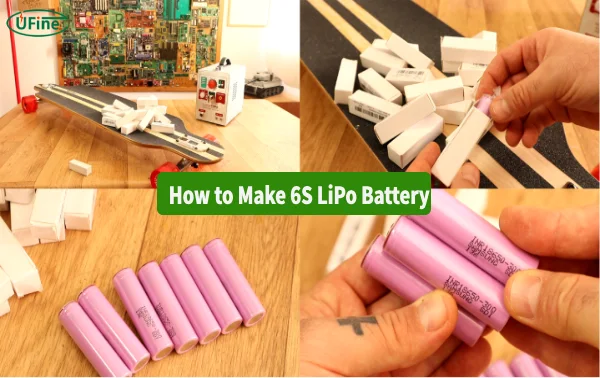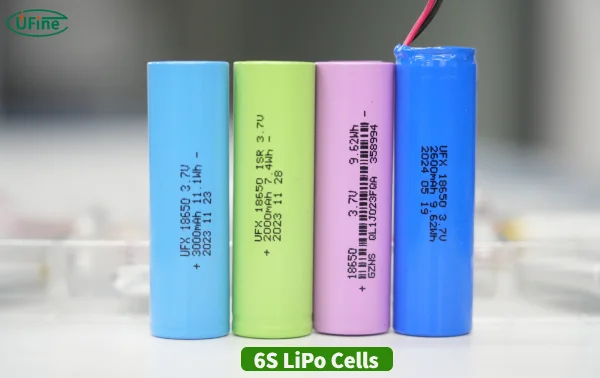In the realm of high-performance devices, the 6S battery stands out. These powerful energy sources are essential for enthusiasts and professionals alike. But what exactly is a 6S battery, and why is it so popular? This article will delve into the details, exploring everything from voltage and types to applications and maintenance. Whether you’re a beginner or an expert, understanding the intricacies of 6S batteries can enhance your projects and decision-making.
Part 1. What is a 6S battery?
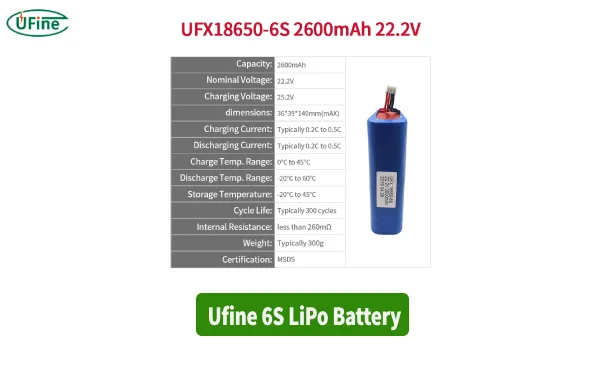
Let’s begin by understanding what a 6S battery is. The term “6S” refers to a battery made up of six cells connected in series. Each cell typically provides a nominal voltage of 3.7 volts, resulting in a total voltage of around 22.2 volts when fully charged. This configuration allows for a higher voltage output, which is crucial for powering devices that require more energy.
Why Choose a 6S Battery?
The 6S battery is favored for its ability to deliver substantial power in a compact form. This makes it an ideal choice for applications like drones, remote-controlled cars, and electric bikes. The efficiency and power output are unmatched by lower-voltage batteries, making 6S batteries a preferred option for performance-oriented devices.
Part 2. 6S battery voltage
Understanding the voltage of a 6S battery is essential for selecting the right power source for your needs. As mentioned earlier, a 6S battery delivers a nominal voltage of 22.2 volts. However, the voltage can vary depending on the state of charge.
Voltage Dynamics
- Fully Charged Voltage: When fully charged, each cell can reach up to 4.2 volts, resulting in a total voltage of 25.2 volts for the entire battery.
- Discharged Voltage: When discharged, the voltage drops to around 3.0 volts per cell, totaling 18 volts across the battery.
This range is crucial for ensuring that the connected device operates within its optimal voltage range. Exceeding or dropping below this range can lead to inefficient performance or potential damage.
Part 3. 6S battery type
The most common type of 6S battery is the lithium polymer (LiPo) battery. LiPo batteries are known for their lightweight, flexible design, and high energy density. These characteristics make them particularly suitable for applications where weight and space are critical factors.
Lithium Polymer (LiPo) Batteries
LiPo batteries have several advantages over other battery types:
- High Energy Density: They store more energy in a smaller package, providing longer runtimes without adding extra weight.
- Flexibility: The thin, flexible cells can be molded into various shapes and sizes, allowing for customization in design.
- Low Self-Discharge Rate: LiPo batteries maintain their charge for longer periods when not in use, reducing the need for frequent recharging.
However, they require careful handling and charging practices to ensure safety and longevity.
Part 4. 6S lipo battery capacity
Capacity is a key factor when choosing a 6S battery. It is measured in milliampere-hours (mAh) and indicates how long the battery can sustain a load before needing recharge.
Choosing the Right Capacity
- Higher Capacity: A higher mAh rating means the battery can provide power for a more extended period, which is beneficial for long-duration activities like drone flights or RC racing.
- Balancing Weight and Capacity: While a higher capacity offers longer runtime, it also adds weight. It’s essential to balance the need for longer operation with the impact on device performance and handling.
For 6s batteries, common capacities include:
- 2200mAh: A common capacity used in racing drones and RC models, offering a good balance between runtime and weight.
- 3000mAh: Offers longer runtime for slightly higher-power applications, without adding too much extra weight.
- 5000mAh: Used in larger drones, electric vehicles, or other devices requiring more power and longer run times.
- 6000mAh and above: Typically found in larger, high-power applications, providing more extended usage time for demanding devices, but at the cost of heavier weight and longer charging times.
Selecting the right capacity depends on the specific requirements of your device and the intended usage duration.
Part 5. C-discharge rate of 6s lipo battery
The C-discharge rate refers to the rate at which a battery discharges its capacity relative to its maximum rated capacity. It is an important parameter for understanding how quickly a battery can provide power without overheating or getting damaged.
-
What is C-Discharge Rate? The discharge rate is usually expressed as a “C” value. For example, a 1C rate means the battery will discharge its full capacity in one hour. If you have a 1000mAh battery with a 1C discharge rate, it will discharge at 1000mA (1A). A higher C rate indicates the battery can discharge faster.
-
How it Affects Battery Performance
- Higher Discharge Rate: A higher C rate allows the battery to deliver more power quickly, which is essential for high-performance applications such as drones, RC cars, and power tools. However, this also generates more heat, which can reduce battery life if not managed properly.
- Lower Discharge Rate: A lower C rate means the battery will discharge more slowly, leading to less heat generation and better overall battery longevity, but it may not be suitable for high-power demand.
-
Common 6s Battery Discharge Rate Common discharge rates for 6s batteries typically range from 20C to 50C. For instance:
- A 20C 6s battery with a capacity of 2200mAh can safely discharge at 44A (2200mAh x 20C = 44,000mA or 44A).
- A 50C battery can discharge at up to 110A, making it suitable for high-power applications like racing drones or performance RC vehicles.
What is a High-Rate Discharge Battery?
Part 6. 6S battery application
The applications of 6S batteries are diverse, thanks to their robust power output and versatility. Here are some common uses:
Drones and UAVs
In the world of drones and unmanned aerial vehicles (UAVs), 6S batteries are prized for their ability to provide consistent power for extended periods. The higher voltage enables drones to carry heavier payloads and perform complex maneuvers with ease.
Remote-Controlled Vehicles
For RC cars, boats, and planes, 6S batteries offer the speed and power necessary for competitive racing and high-speed performance. The lightweight nature of LiPo batteries ensures that these vehicles remain agile and responsive.
Electric Bikes and Scooters
In the realm of personal transportation, 6S batteries power electric bikes and scooters, providing the voltage needed to tackle inclines and cover longer distances without frequent recharges.
Part 7. Charging and maintenance
Proper charging and maintenance are crucial for getting the most out of your 6S battery. Here are some tips to ensure longevity and safety:
Charging Tips
- Use a Compatible Charger: Always use a charger designed for LiPo batteries, with the correct voltage and current settings for a 6S configuration.
- Monitor Charging: Keep an eye on the charging process, and never leave a charging battery unattended. This helps prevent overcharging, which can lead to overheating and damage.
Maintenance Practices
- Storage: Store batteries in a cool, dry place to prevent degradation. Avoid storing them at full charge or completely discharged; a 50% charge is ideal for storage.
- Regular Inspections: Check batteries for any signs of swelling, damage, or wear. Replace any compromised batteries to ensure safety and performance.
Part 8. How long does a 6S lipo battery last?
The lifespan of a 6S battery depends on several factors, including usage patterns and maintenance. On average, a well-maintained 6S battery can last for about 300 to 500 charge cycles.
Maximizing Lifespan
- Avoid Deep Discharges: Try not to fully discharge your battery regularly, as this can shorten its lifespan.
- Temperature Control: Keep batteries away from extreme temperatures, both hot and cold, as these can adversely affect performance and longevity.
Part 9. 6s lipo battery charger type
When charging a 6s battery, choosing the right charger is essential for safety, efficiency, and longevity. Here are the common types of chargers for 6s batteries:
-
LiPo Battery Charger: Since most 6s batteries are LiPo (Lithium Polymer), a LiPo battery charger is required. These chargers are specifically designed to safely charge LiPo batteries with multiple cells (like 6s configurations) and manage each cell individually.
-
Balance Chargers: These chargers not only charge the entire battery but also balance the cells to ensure each one reaches the same voltage level. This helps to prevent overcharging or undercharging of individual cells, ensuring the battery’s longevity and performance.
-
Smart Chargers: Some advanced smart chargers are equipped with features like automatic cell balancing, temperature monitoring, and charge cycle tracking, which provide enhanced safety and efficiency.
-
Charger Specifications: When choosing a charger for a 6s battery, ensure it supports charging up to 25.2V (the total voltage of a fully charged 6s battery, with 4.2V per cell) and has an output current appropriate for the battery’s capacity (usually between 1C to 2C for most applications).
Part 10. How to choose the best 6s lipo battery?
Choosing the right 6s battery for your device or application can significantly impact performance, runtime, and safety. Here are the key considerations when selecting the best 6s battery:
-
Capacity (mAh or Ah): Select a battery with the appropriate capacity for your device’s power requirements. Higher capacity batteries (e.g., 5000mAh or 6000mAh) offer longer runtime but can be heavier.
-
Discharge Rate (C-Rate): Ensure the battery’s C-rate is high enough to meet the power demands of your application. For instance, if you’re using the battery in a high-performance drone, look for a discharge rate of 20C or higher.
-
Battery Chemistry: The most common chemistry for 6s batteries is LiPo (Lithium Polymer), but LiFePO4 batteries may be used for more safety-conscious applications. LiPo offers higher energy density, while LiFePO4 offers longer lifespan and more thermal stability.
-
Voltage: Ensure the battery’s voltage is compatible with your device’s voltage requirements. For a 6s battery, the nominal voltage is 22.2V, and the fully charged voltage is 25.2V. Make sure your device can handle this voltage range.
-
Weight: If weight is a concern (e.g., for drones or RC cars), choose a battery with an appropriate capacity that doesn’t add unnecessary bulk. Larger capacity batteries tend to be heavier.
-
Brand Reputation and Reviews: Choose reputable brands known for high-quality, reliable batteries. Checking user reviews and performance data can help you avoid poor-quality or counterfeit batteries.
-
Size and Fit: Ensure the 6s battery fits in your device or battery compartment. Even though 6s batteries have standardized dimensions (around 135mm x 46mm x 25mm), always double-check the fit for your specific application.
Part 11. Custom 6S battery manufacturer
For those with specific needs, custom 6S batteries may be the solution. Ufine, a renowned Chinese lithium battery manufacturer, offers customization services for various types of batteries, including lithium polymer, cylindrical, and LiFePO4 batteries.
Customization Options
Ufine provides options to tailor the working shape, size, capacity, and voltage of batteries. This ensures that your battery meets the exact specifications required for your application, offering both flexibility and precision.
Related Tags:
More Articles

How to Choose the Best Floor Scrubber Battery for Commercial Cleaning?
Selecting the ideal floor scrubber battery ensures a long runtime, rapid charging, and minimal maintenance for efficient commercial cleaning operations.
Battery for Blower vs Battery for Leaf Vacuum: Which One Should You Choose?
Battery for blower vs leaf vacuum—learn the key differences in power, fit, and runtime to choose the right battery for your outdoor tool needs.
How to Choose the Right Battery for Blower?
Choosing the right blower battery? Consider voltage, capacity, chemistry & usage. This guide helps match the best battery for peak performance.
How to Choose the Best Insulated Battery Box for Lithium Batteries?
Choosing the Best Insulated Battery Box for Lithium Batteries? Discover key factors such as size, material, and safety for optimal protection and performance.
7 Critical Elements on a Lithium Battery Shipping Label
What must be on a lithium battery shipping label? Learn 7 key elements to ensure safety, legal compliance, and correct handling across all transport modes.
